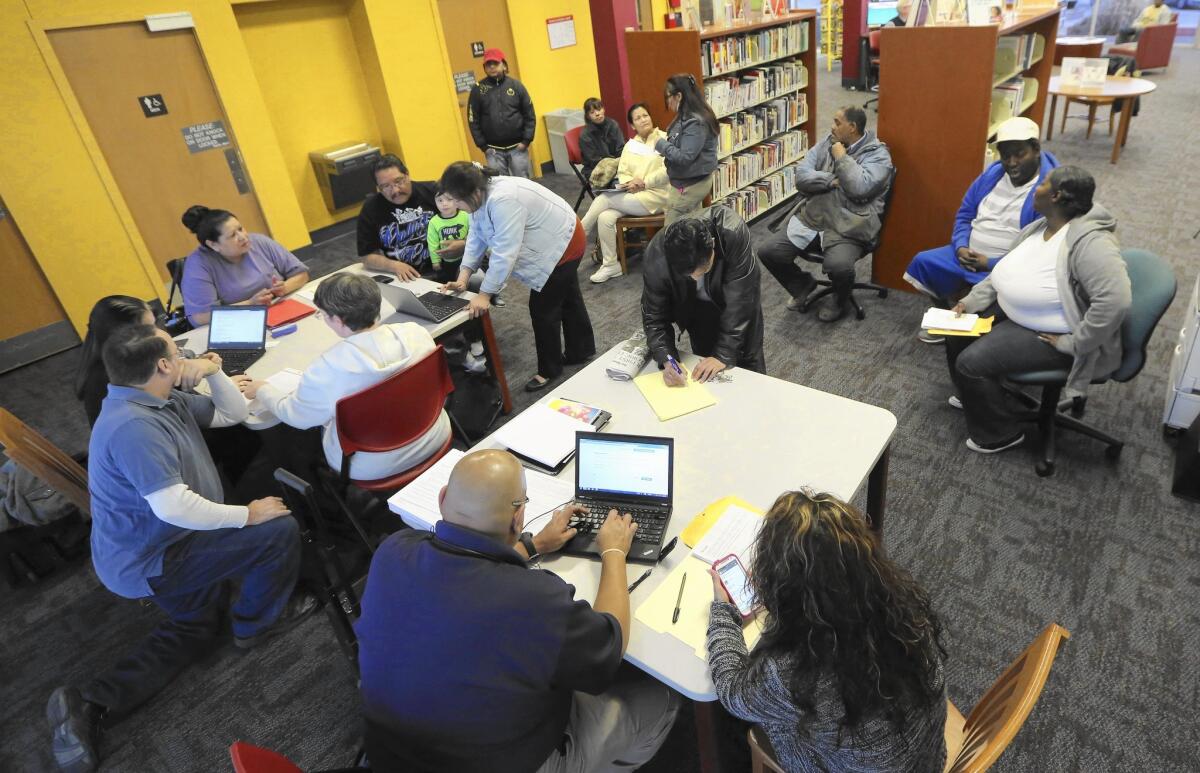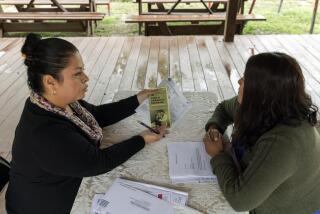Poverty persists but more have healthcare

A steadily growing job market and higher minimum-wage laws in pockets of the country failed to reduce the nation’s poverty rate last year or reverse the long-running trend of stagnating incomes for most American households.
The Census Bureau’s annual figures on income and poverty, released Wednesday, came as a disappointing surprise to experts.
Many analysts had expected that the improving economy would reduce the poverty level for a second straight year. But the share of people in the U.S. living in poverty was 14.8% last year, essentially unchanged from 2013.
Most Americans, meanwhile, did not make up incomes lost during the Great Recession, despite an acceleration of job growth last year. The median income — or the point at which half the households make more and half less — was $53,700 last year, not statistically different from the previous year and down 6.5% from 2007 on an inflation-adjusted basis.
More encouraging, however, was a related report from the bureau on another indicator of economic well-being: The number of Americans without health insurance fell sharply last year.
Thanks mostly to the first full-year impact of the Affordable Care Act, also known as Obamacare, the percentage of people without medical coverage fell to 10.4% from 13.3% the previous year. That represents a drop of 8.8 million, to 33 million people who were uninsured for part or all of last year.
A decline was expected. Earlier surveys suggested a big increase in health plan enrollment as states expanded Medicaid and millions of Americans signed up for private insurance through new marketplaces created by Obamacare. Every state, racial group and age of individuals saw a decline in the uninsured rate, the Census Bureau said.
Proponents held up the new report as proof of the health program’s success, despite the bungled launch of the marketplaces and persistent opposition to Obamacare from Republican lawmakers.
The decrease in the uninsured was “historic,” said Ron Pollack, executive director of the consumer group Families USA.
“The numbers show that the greatest gains were among moderate income families, communities of color and young people – the precise groups that most needed help in gaining health insurance,” Pollack said.
Uninsured rates were considerably higher in Texas, Florida and some other states in the South that have resisted Medicaid expansions. California’s uninsured percentage remains higher than the national rate, attributed in part to its large immigrant population, including undocumented immigrants.
Still, analysts expect the nation’s overall share of the uninsured to drop further as more people become familiar with the mandate and the federal and state marketplaces.
“The numbers in 2015 will be better than in 2014, and better still in 2016,” said Henry Aaron, a senior fellow at the Brookings Institution.
The Census Bureau’s tally of the poor showed that 46.7 million people, a record high, were living in poverty last year. The poverty line was $24,008 for a household of two adults and two children, and it was $12,316 for a person under 65 living alone.
The overall 14.8% level was close to a three-decade high of 15.1%. The 30-year low was 11.3% in the year 2000.
The relatively high poverty rate reflects the way companies have turned more to part-time and other arrangements that have reduced labor’s share of the economic fruits, said Sheldon Danziger, president of the Russell Sage Foundation, which supports research on poverty and other social issues.
“There are a lot of practices that have come in — some aided by technologies — that have allowed employers to cut back on their wage costs,” Danziger said.
Poverty levels held steady for most groups, but one exception was the better-educated. The poverty rate for those with at least a college degree rose to 5% last year from 4.4% in 2013, an increase that analysts speculated could stem partly from the employment struggles of recent graduates entering a tough job market.
The Census Bureau’s supplemental measure of poverty, which includes noncash income such as food stamps and income tax credits, showed a 0.5 percentage point decline in the poverty rate from 2013 to 2014.
On incomes, U.S. households on average made no headway last year, despite an increase in the number of year-round full-time workers.
Since record-keeping began in 1967, the real median household income peaked at $57,843 in 1999, and it came close to matching that in 2007 — just before the full-blown economic downturn. But incomes have been essentially flat for the last three years.
A large increase in people living in non-family households may explain the lack of gain in median income last year, said Edward J. Welniak Jr., the Census Bureau’s chief statistician on incomes. Those households, which consist of people living alone, with roommates or in other nontraditional family arrangements, tend to have lower incomes, thus pulling down overall income.
During the slow recovery of recent years, more young adults moved back in or stayed longer than usual in their parents’ house. “Maybe they’re popping out of their parents’ basement,” said William Frey, a Brookings demographer, offering a possible explanation of the growth in the nontraditional household.
So far this year, there’s been little indication of an acceleration in wages for the average worker, though economists expect employers to raise workers’ pay as they find it harder to fill openings with the lower unemployment rate, which fell to 5.1% in August.
The White House Council of Economic Advisers said it was looking for strong growth this year in median household income. Total weekly earnings of private-sector workers have been rising more rapidly than last year, the council said, and these data are a better predictor of median income trends than average wages.
Chris Christopher Jr., an economist at IHS Global Insight, agreed that real median household income should turn up this year, in part, because inflation has been so modest. But he said he didn’t expect household income to pass its 2007 level until 2019.
“The Great Recession was brutal to many middle- and lower-income households,” he said in a commentary on the Census report Wednesday.
“The poor performance of real median household income and elevated poverty rates have caused a bifurcation in consumer spending patterns,” he said. “Discount stores are doing well and luxury is doing great, while the middle-tier retailers are having a hard time gaining traction.”
The Census report showed that incomes for households across economic classes were essentially flat last year.
But the top 10% of households in income reported earnings last year that surpassed 2007 figures. Incomes for households in all other groups were below 2007 levels.







